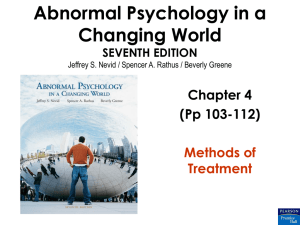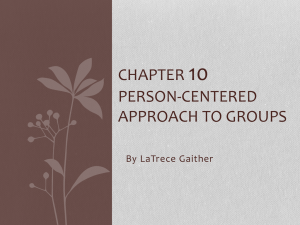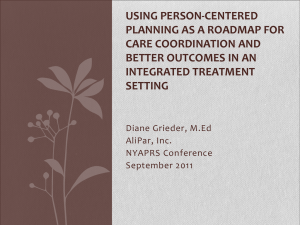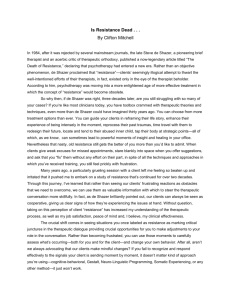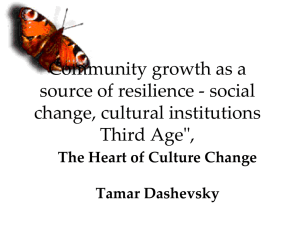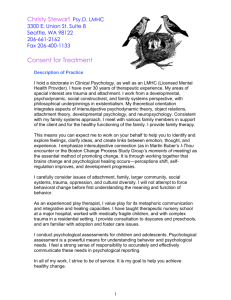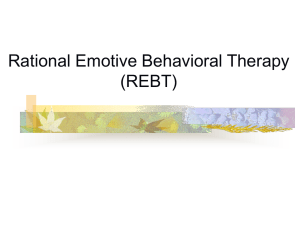Person-centered therapy: A pluralistic perspective
advertisement
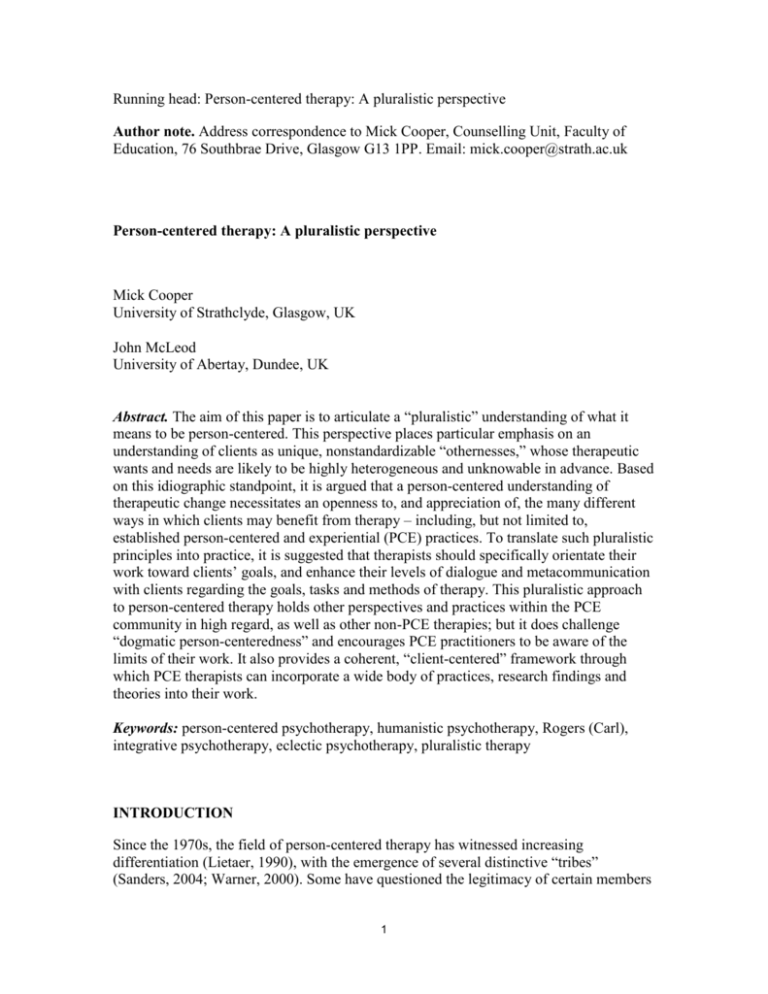
Running head: Person-centered therapy: A pluralistic perspective Author note. Address correspondence to Mick Cooper, Counselling Unit, Faculty of Education, 76 Southbrae Drive, Glasgow G13 1PP. Email: mick.cooper@strath.ac.uk Person-centered therapy: A pluralistic perspective Mick Cooper University of Strathclyde, Glasgow, UK John McLeod University of Abertay, Dundee, UK Abstract. The aim of this paper is to articulate a “pluralistic” understanding of what it means to be person-centered. This perspective places particular emphasis on an understanding of clients as unique, nonstandardizable “othernesses,” whose therapeutic wants and needs are likely to be highly heterogeneous and unknowable in advance. Based on this idiographic standpoint, it is argued that a person-centered understanding of therapeutic change necessitates an openness to, and appreciation of, the many different ways in which clients may benefit from therapy – including, but not limited to, established person-centered and experiential (PCE) practices. To translate such pluralistic principles into practice, it is suggested that therapists should specifically orientate their work toward clients’ goals, and enhance their levels of dialogue and metacommunication with clients regarding the goals, tasks and methods of therapy. This pluralistic approach to person-centered therapy holds other perspectives and practices within the PCE community in high regard, as well as other non-PCE therapies; but it does challenge “dogmatic person-centeredness” and encourages PCE practitioners to be aware of the limits of their work. It also provides a coherent, “client-centered” framework through which PCE therapists can incorporate a wide body of practices, research findings and theories into their work. Keywords: person-centered psychotherapy, humanistic psychotherapy, Rogers (Carl), integrative psychotherapy, eclectic psychotherapy, pluralistic therapy INTRODUCTION Since the 1970s, the field of person-centered therapy has witnessed increasing differentiation (Lietaer, 1990), with the emergence of several distinctive “tribes” (Sanders, 2004; Warner, 2000). Some have questioned the legitimacy of certain members 1 of this family (e.g., Brodley, 1990), but with an increasing emphasis on “inclusivity and the embracing of difference” within the PCE world (Sanders, 2007, p. 108), many now see this diversity as a positive quality to be prized (e.g., Cooper, O’Hara, Schmid, & Wyatt, 2007). From this standpoint, each of the members of the PCE family can be seen as drawing on, and developing, different elements of Rogers’ work. While those who identify with a “classical client-centered” standpoint, for instance, can be seen as orientating primarily around Rogers’ (1942) concept of nondirectivity (e.g., Bozarth, 1998; Brodley, 1990); emotion-focused/process-experiential therapists (e.g., Greenberg, Rice, & Elliott, 1993) can be understood as placing more stress on the affective experiences and processes that Rogers placed at the heart of the therapeutic enterprise (e.g., Rogers, 1959). The aim of this paper is to introduce, and critically discuss, an alternative reading of what it means to be person-centered. This is one that is primarily rooted in the idiographic assumptions underlying the person-centered worldview: that each individual is distinct, and that the role of the therapist should be to facilitate the actualization of the client’s unique potential in the way that best suits the individual client. PERSON-CENTERED VALUES: PRIZING THE UNIQUENESS OF HUMAN BEING AND BECOMING Person-centered therapy, as with other humanistic and existential approaches, can be understood as a form of counseling and psychotherapy which puts particular emphasis on “conceptualizing, and engaging with people in a deeply valuing and respectful way” (Cooper, 2007, p. 11). As a consequence of this, a key element of person-centered thought is a rejection of psychological and psychotherapeutic systems which strive to reduce individual human experiences down to nomothetic, universal laws and mechanisms. Rather, there is an emphasis on viewing each human being “as a unique entity, unlike any other person who has existed or will exist” (Cain, 2002, p. 5). In other words, while person-centered theorists have argued that certain psychological features, such as the need for positive regard or conditions of worth (Rogers, 1959), are universal, there is a particular emphasis on the fact that each human being is distinctive, irreplaceable and inexchangeable. Levitt and Brodley (2005, p. 109), for instance, stated that client-centered therapy “is not centered on what a general client would or should be. It is not centered on a theory external to the client…. The focus of the therapist is entirely on understanding the client as an individual, in all his uniqueness, from moment to moment.” In Rogers’ work, this idiographic emphasis is particularly evident in his assertion of the “fundamental predominance of the subjective” (Rogers, 1959, p. 191). Each individual, for Rogers (1951, p. 483), “exists in a continually changing world of experience of which he is the center”; and, given that this ever-changing phenomenological experiencing will be unique to the individual, the very essence of each human reality is distinct. Rogers’ (1942) idiographic emphasis is also evident in his critical stance toward diagnosis, preferring to view human beings as unique, individual organisms rather than as manifestations of trans-individual dysfunctional states. This emphasis on the psychological irreducibility of each client, however, is not merely a theoretical assumption, but is rooted in a deep ethical commitment within the 2 person-centered field to engaging with an Other in a profoundly honoring way. Here, the work of the French philosopher Emmanuel Levinas (1969, 2003) has been particularly influential (e.g., Cooper, 2009; Schmid, 2007; Worsley, 2006), with his emphasis on the “absolute difference” of the Other (Schmid, 2007, p. 39): that they are “infinitely transcendent,” “infinitely foreign,” “infinitely distant,” “irreducibly strange.” For Levinas, the Other always overflows and transcends a person’s idea of him or her, is impossible to reconcile to the Same, is always more than – and outstrips – the finite form that they may be afforded. From this standpoint, then, it is not just that each human being is unique, but that each human being is so unique that they can never be fully understood by an other: Their difference, at least to some extent, is transcendent. This is similar to Rogers’ (1951, p. 483) statement that the private world of the individual “can only be known, in any genuine or complete sense, to the individual himself.” This idiographic emphasis within the person-centered approach is associated with a theory of psychotherapeutic change in which there is a particular emphasis on helping clients to actualize their distinctive potential and become their “own unique individual self” (Rogers, 1964, p. 130). Person-centered therapy (Rogers, 1957, 1959) aims to provide clients with a set of therapeutic conditions in which they can reconnect with their actual, individual experiences and valuing processes, moving away from a reliance on more external, “leveled down” (Heidegger, 1962) judgments and introjects. An emphasis on the distinctiveness of each human being and their change processes also means that each individual’s needs and wants can be considered, at least to some extent, unique and unknowable. Bozarth (1998) wrote that the process of actualization – the motivational tendency underpinning all growth and development – “is always unique to the individual” (Bozarth, 1998, p. 29); and he described it as an “idiosyncratic” (Bozarth, 1998, p. 24) process that cannot be predicted (or determined) by another. A commitment to supporting the actualization of the Other in their own, unique way also reflects a fundamental person-centered ethic of respect for the client’s autonomy (Keys & Proctor, 2007). Grant (2004) has argued that the basis for person-centered therapy lies in the ethic of “respecting the right of self determination of others” (Grant, 2004, pp. 158). Similarly, Cain (2002, p. 5) stated that “A fundamental value of humanistic therapists is their belief that people have the right, desire, and ability to determine what is best for them and how they will achieve it.” In Levinas’s (1969, p. 47) terms, this could be described as a fundamental ethical commitment to letting the Other be in all their Otherness: a “non-allergic reaction with alterity.” TOWARD A “PLURALISTIC” PERSPECTIVE At the heart of a person-centered approach, then, is an understanding that human beings may want and need different things, and that an individual’s distinctive wants and needs should be given precedence over any generalized theories that another holds about them. Extrapolated to the therapeutic process, this suggests that a basic person-centered assumption should be that clients are likely to want and need many different things from therapy – both things traditionally associated with PCE practice (such as empathic understanding responses) and things not (such as Socratic questioning) – and that any 3 generic theories of change that we, as therapists, may hold, should be subordinate to the client’s specific needs and wants. The hypothesis that different clients want different things from therapy is supported by empirical research (see Cooper & McLeod, 2011 for a review of the research). In a major trial (King, et al., 2000), for instance, primary care patients for whom a brief therapeutic intervention was indicated were given the option of choosing between nondirective counseling or cognitive-behavior therapy (CBT). Of those patients who specifically opted to choose one of these two therapies, around 40% chose the nondirective option, while 60% chose the CBT. Interestingly, however, follow-up research by Lee (2009) found significant differences between males and females, with more males expressing a preference for CBT but more females expressing a preference for nondirective counseling. Of course, what clients believe they want is not, necessarily, what they need, nor what will necessarily be of greatest benefit to them. However, an emerging body of evidence indicates that different clients do, indeed, benefit from different types of therapeutic practices. While there is clear evidence, for instance, that most clients do best when levels of empathy are high (Bohart, Elliott, Greenberg, & Watson, 2002), there are some clients – individuals “who are highly sensitive, suspicious, poorly motivated” – who seem to do less well with highly empathic relationships (Bohart, et al., 2002, p. 100). There is also evidence that clients with high levels of resistance and with an internalizing coping style tend to do better in nondirective therapies, while those who are judged to be nondefensive and who have a predominantly externalizing coping style tend to benefit from more technique-orientated approaches (Beutler, Blatt, Alimohamed, Levy, & Angtuaco, 2006; Beutler, Engle, et al., 1991; Beutler, Machado, Engle, & Mohr, 1993; Beutler, Mohr, Grawe, Engle, & MacDonald, 1991). Within the PCE field, this assumption – that different clients may benefit from different therapeutic practices (at different points in time) – has been articulated particularly well by Bohart and Tallman (1999). Process-experiential/emotion-focused therapists (e.g., Greenberg, et al., 1993) have also argued, and demonstrated, that particular therapeutic methods may be more or less helpful at particular moments in the therapy. In addition, from texts such as Keys’s (2003) Idiosyncratic Person-Centred Therapy and Worsley’s (2004) “Integrating with integrity,” it is evident that many person-centered therapists already incorporate a wide range of therapeutic methods into their work. Cain (2002, p. 44) wrote that one of the primary ways in which humanistic therapies have evolved is in their diversity and individualization in practice, and he went on to state that, ideally, humanistic therapists: … constantly monitor whether what they are doing “fits,” especially whether their approach is compatible with their clients’ manner of framing their problems and their belief about how constructive change will occur. Although the focus of humanistic therapies is primarily on the relationship and processing of experience, they may use a variety of responses and methods to assist the client as long as they fit with the client’s needs and personal preferences. In recent years, Cooper and McLeod (2007, 2011) have come to describe this standpoint, which prioritizes the therapist’s responsiveness to the client’s individual wants and needs, 4 as a “pluralistic” one. This is a stance which holds that “there is no, one best set of therapeutic methods,” and has been defined as the assumption that “different clients are likely to benefit from different therapeutic methods at different points in time, and that therapists should work collaboratively with clients to help them identify what they want from therapy and how they might achieve it” (2011, pp. 7–8). Cooper and McLeod’s pluralistic approach emerges from the person-centered values and practices discussed above, but it has been presented as a way of thinking about, and practicing, therapy which extends these values to the whole psychological therapies domain. In terms of translating this general pluralistic stance into concrete therapeutic practice, Cooper and McLeod (2007, 2011) have emphasized two particular strategies. The first is to specifically orientate the therapeutic work around the client’s goals, and the second is to develop the degree of negotiation, metacommunication and collaboration in the therapeutic relationship. CLIENTS’ GOALS AS AN ORIENTATING POINT FOR THERAPY Cooper and McLeod (2007, 2011) have suggested that the goals that clients have for therapy can – and should – serve as an orientating point for thinking about, practicing, and evaluating therapeutic work. A client, for example, may want “to feel a sense of selfworth,” “to not experience anger and distrust toward my husband,” or “to be able to think about work without feeling stressed or panicky.” From a more classical person-centered standpoint, there is a risk that such a goal focus can lead to an overly mechanistic and ends-oriented approach to therapy, but there are several reasons why it is also highly consistent with a person-centered approach. First, it fits strongly with the concept of the client as active, meaning-orientated agent (Bohart & Tallman, 1999), who is engaged in constructing his or her life and relationships. Second, it privileges the client’s perspective – regarding what he or she want both in life and from therapy – over the therapist’s. Third, it moves away from a diagnostic, or even problem-centered, understanding of the client and the therapeutic process toward a potentiality-centered one – based around where the client wants to “go” in their lives. Finally, an orientation around the client’s goals may be the most explicit way of meeting, and responding to, the client as a selfdetermined, agentic subjectivity, who has the right to choose for him- or herself how he or she would like to pursue their own process of actualization. In order to help clients reach their goals, Cooper and McLeod (2007, 2011) have suggested that it may also be useful to think about the particular pathways by which these can be attained. Cooper and McLeod (2011, p. 12) refer to such possibilities as “tasks”: “The macro-level strategies by which clients can achieve their goals.” Examples of common tasks within therapy might include: “making sense of a specific problematic experience,” “changing behavior,” “negotiating a life transition or developmental crisis,” “dealing with difficult feelings and emotions,” and “undoing self-criticism and enhancing self-care.” Note, while process-experiential/emotion-focused therapists also refer to therapeutic “tasks” (e.g., Elliott, Watson, Goldman, & Greenberg, 2004), Cooper and McLeod use the term in a somewhat higher order sense: to refer to more general pathways or strategies. By contrast, the specific, micro-level concrete activities that clients and therapists undertake to complete these tasks are referred to as “methods,” such as “listening,” “participating in two-chair dialogue,” and “undertaking a guided 5 visualization.” Cooper and McLeod also distinguish between the “therapist activities” that form one part of a therapeutic method and the “client activities.” Such a distinction may be useful when thinking about the kinds of therapeutic “methods” that clients may undertake outside of the immediate therapeutic relationship: for instance, reading selfhelp literature, exercising, or talking to friends and partners. COLLABORATIVE ACTIVITY This goal–task–method framework provides a means for therapists to think about what kind of therapeutic practices may be most helpful to a particular client. Of much more importance, however, is that it highlights three key domains in which collaborative activity can take place within the therapeutic relationship. For Cooper and McLeod (2007, 2011), such collaborative activity needs to be a key element of a pluralistically informed approach to therapy: maximizing the extent to which clients’ perspectives, wants and agencies can inform the therapeutic work. Rennie (1998) and Kiesler (1988) referred to such collaborative activity as “metacommunication,” and it may be particularly appropriate in a first or early session of therapy: talking to clients about what they would like to get out of the therapeutic work, and how they feel that they might be able to get there. For example, a therapist might ask: “Do you have a sense of what you want from our work together?” “What do you hope to get out of therapy?” “If you were to say just one word about what you wanted from this therapy, what would it be?” “Do you have a sense of how I can help you get what you want?” “What have you found helpful in previous episodes of therapy?” “How would you like me to be in this therapeutic relationship: more challenging, more reflective?” Although metacommunicative activity is primarily orientated toward clarifying the client’s perspective, it by no means requires the therapist to ignore his or her own views and experience. Rather, the emphasis is on a dialogue between both members of the therapeutic dyad (Cooper & Spinelli, in press), in which therapist and client draw on their particular bodies of knowledge and expertise. Hence, the goals, tasks and methods of therapy emerge through a collaborative, negotiated dialogue; and may continue to be changed as the therapy unfolds. An example of dialogue and metacommunication around a client’s goals for therapy comes from Mick’s work with a young man, Alex (details of clients have been changed to preserve anonymity). Alex was from a working class background, and had recently chosen to leave college feeling that he could no longer cope with his feelings of anxiety and depression. Alex began the session talking about his current difficulties, and the physical abuse he had experienced from his mother as a child. Alex: Obviously the fact that it was my mum that I got the abuse from makes it a lot harder. Because I kind of feel that people look at me a little bit – There’s always this sense of attack. 6 Mick: There’s an underlying sense of attack from people. Alex: It’s kind of paranoid in a way. It kind of annoys me that I’m still doing it, but it doesn’t make any difference. It doesn’t stop. It’s not even getting gradually better now that I’ve realized – everything’s just exactly the same, but … more frustrating because I know that it’s going to take time, but I feel that I’m kind of at a standstill, and don’t know really where to go …. At this point, Mick invited Alex to try and specify more clearly where he would like therapy to take him to with this difficulty. Mick: So, if we were to, kind of, think about specific things that you’d want from the counseling, it sounds like one of the things would be around – what would it be? Would it be about not wanting to experience people as so critical or … How would you phrase some of the things that you’d want? So – where – like in 15 or 20 sessions, where would you like to be at the end of it, in contrast to now? Alex: I suppose I’d like to improve my personal relationships, in the sense that I have more self-worth. Because … mm … in arguments and upsets … I value myself a lot less than I should. I just let people get their own way, just because it makes things easier …. I take a lot of hits from other people. Mick: So there is something about wanting to feel more of a sense of self-worth? Alex: Yeah, in that I can make these objections and that my feelings are equal to the other persons. Mick: So something about being able to feel that my opinions and what I want is valid, and not put other people’s first. Alex: Yeah. These goals, as identified by Alex, then served as an orientating point to the ongoing therapeutic work. A second example of this dialogical process, with respect to collaboration around therapeutic methods, comes from McLeod’s work with a young male client, Haruki. During one of the early sessions that focused on the task of dealing with his panic feelings, John and Haruki talked together about the various ways that Haruki thought that it might be possible for them to address this issue. John wrote down the ideas that emerged, on a flipchart. Haruki began by saying that the only thing that came to mind for him was that he believed that he needed to learn to relax. John then asked him if there were any other situations that were similar to performing in seminars, but which he was able to handle more easily. He could not immediately identify any scenario of this type, but later in the session he returned to this question, and told John that he remembered that he always took the penalties for his school soccer team, and dealt with his anxieties by running through in his mind some advice that he had received from his grandfather, about following a fixed routine. John then asked him if he would like to hear some of 7 John’s suggestions about dealing with panic. John emphasized that these were only suggestions, and that it was fine for him to reject them if they did not seem useful. John mentioned three possibilities. One was to look at a model of panic, as a way of understanding the process of losing emotional control. The second was to use a two-chair method to explore what was going on in his mind, in terms of what he was internally saying to himself at panic moments. The third was to read a self-help booklet on overcoming panic. (Cooper & McLeod, 2011, p. 93) From a person-centered standpoint, one counterargument to this call for greater metacommunication (as mentioned above) might be that what clients want in therapy – or what they believe themselves to want – is not necessarily what they need. Clients may have introjected, for instance, certain beliefs about what will be most helpful to them (such as external advice or suppression of emotions), and this may run counter to their actual organismic valuing (Rogers, 1959). As indicated above, however, metacommunication does not simply involve doing whatever the client wants; if the therapist has a different view of what might be helpful, this is something that can be brought into the dialogue. Having said that, any therapeutic approach which claims to be client-centered needs to be very careful not to dismiss, minimize or override a client’s own views of what it is they want. Moreover, research suggests that clients who get the therapeutic interventions that they want do tend to experience more benefit, and are much less likely to drop out, than those who do not (Swift & Callahan, 2009). A second counterargument to this call for greater metacommunication may be that it overemphasizes verbal and conscious communication processes in the therapeutic relationship, and overlooks the value of more subtle, nonconscious and intuitive understandings: such as the therapist’s felt-sense of what the client needs, or their embodied empathic understanding (Cooper, 2001). However, research tends to suggest that therapists, in fact, are generally not that good at accurately intuiting what their clients really want or are experiencing (see Cooper, 2008, p. 2). Moreover, a substantial body of research on “client deference” indicates that clients are often very wary of communicating to their therapists what it is that they really want or need (Rennie, 1994) – including to person-centered therapists – and will often hide things from their counselors or psychotherapists (Hill, Thompson, Cogar, & Denman, 1993). Hence, although overt, explicit communication may not be the only channel through which therapists can develop a greater understanding of their clients’ actual wants and needs, empirical research suggests that this is one mode of communication that many therapists could utilize more fully. Indeed, given the difficulties that clients may have directly expressing their goals, wants, and preferences to their therapists, Cooper and McLeod (2011) have suggested a range of tools and measures that therapists may want to incorporate into the therapeutic process. For instance, the “Therapy Personalisation Form” invites clients to indicate on a range of dimension how they might like their therapist to be: such as, “Be more challenging – Be more gentle,” “Focus more on my feelings – Focus more on my thoughts and cognitions,” “Allow more silence – Not allow so much silence” (download from www.pluralistictherapy.com). Another tool that has been developed is a simple “Goal Assessment Form,” where clients’ goals for therapy are jotted down in an assessment session (and revised if necessary), and then rated every week on a 1 (Not at 8 all achieved) to 7 (Completely achieved) scale. For Alex (discussed above), for instance, three of his identified goals were to “Feel a sense of self-worth,” “Feel that my opinions and wants are valid in relationships,” and “Not interpreting what others say and do in critical way.” At assessment, the average rating across these three items was 1.33 (i.e., very close to “Not at all achieved”) and, by session five, had increased to 3. IMPLICATIONS FOR ESTABLISHED PERSON-CENTERED AND EXPERIENTIAL APPROACHES A pluralistic reading of person-centered therapy does not, in any way, challenge the value or legitimacy of other perspectives and practices within the PCE field. Nor does it call on all PCE therapists to be more integrative in their work. Cooper and McLeod (2011) make a clear distinction between pluralism as a perspective on psychotherapy and counseling, and pluralism as a particular form of therapeutic practice. Hence, a therapist who offers classically orientated client-centered therapy could still subscribe to a pluralistic viewpoint: believing that there are many different ways of helping clients, even though they choose to specialize in just one. More specifically, it may be useful to think about a pluralistic approach as residing on a spectrum: from a simple acknowledgment of the value of different therapeutic methods; to an enhanced use of goal orientation, metacommunication and negotiation in the therapeutic work; to a therapeutic practice that draws on methods from a wide range of orientations. Even at a most minimal level, however, what a pluralistic perspective does offer is a challenge to the assumption that any one person-centered perspective, method or set of hypotheses holds some kind of “metanarrative” status (Lyotard, 1984): that it is true, or superior, for all people at all times. More than that, it challenges “dogmatic personcenteredness” (Worsley, 2001, p. 25): the belief that person-centered and experiential theories or methods are in some, generic way superior to other therapeutic practices and understandings. Rather, it invites members of the person-centered community to hold our person-centered theories and practices “lightly,” and to be open to challenges and different viewpoints from both within, and outside of, the person-centered field. At this level, it invites us to be “person-centered” about person-centered therapy: nondefensive, open to a range of experiences, and willing to be “in process” rather than holding a fixed and rigid concept of self (Rogers, 1961). A pluralistic perspective also invites PCE therapists to be more explicit about the particular ways in which our therapies may be able to help people; and the kinds of clients and contexts for which they may be most likely to be helpful. Person-centered and experiential therapists, for instance, might find it useful to undertake a “personal audit,” looking at the kinds of goals they feel most able to help clients to achieve, and the particular methods they would have for getting them there. This is something that might then be made clearer to clients prior to starting therapy, such that clients are more enabled to decide whether or not a PCE therapy is right for them. Further empirical research would be particularly helpful in this regard. For instance, we already know that clients with high levels of reactivity tend to be more likely to benefit from nondirective methods than clients with low levels of reactivity, but are there other groups of clients, or 9 problems, or goals for which PCE methods or a PCE attitudinal stance may often be of greatest help? Finally, for those interested in moving toward a more pluralistic practice, the pluralistic strategies outlined by Cooper and McLeod (2011) may help PCE practitioners to enhance their work through greater dialogue around the goals, tasks and methods of therapy. And for PCE practitioners who are interested in incorporating other methods into their work, it provides a framework in which this can be achieved in a coherent and client-centered way. DISCUSSION Our hope is that the articulation of a pluralistic understanding of what it means to be person-centered will bring something fresh and vibrant to the person-centered field, even if it primarily involves the explication of something that has always been implicit. First, a pluralistic perspective offers PCE therapists a means of resolving the tension between commitment and antidogmatism (Hutterer, 1993). It provides a conceptual framework in which PCE therapists can feel proud of the work that they do and can develop and deepen this specialism, while at the same time avoiding a judgmental attitude toward other therapeutic orientations. More than this, it has the opportunity to give PCE therapists a unique identity in the therapeutic field: as champions of inclusivity and mutual respect across therapies. Second, closely related to this, it facilitates the building of bridges with other progressive, client-orientated approaches, such as the “client-directed” practices of Duncan, Hubble, Sparks and colleagues (2004) and the work of many postmoderninformed family therapists (see Sundet, 2011). Third, a pluralistic perspective on therapy provides a means of conceptualizing, not just processes within the counseling and psychotherapeutic domain, but the whole range of personal development activities. In this way, a pluralistic perspective can help the person-centered and humanistic field move away from an exclusive focus on how professional therapists “bring about” change in clients, and toward a more client-orientated and client-agentic stance (Bohart & Tallman, 1999). Fourth, a pluralistic viewpoint provides a means by which person-centered practices can be more fully opened up to new and emerging research – as well as new theories and ideas – such that it can remain a growing and actualizing field. Closely linked to that, it provides a framework for researching and thinking about the complex question of how therapists can most constructively engage with our clients’ individual wants and needs. Finally, for some person-centered practitioners, the development of a pluralistic practice may allow them to grown more fully as therapists. It provides a highly flexible model of practice in which therapists can incorporate, and advance, whatever potentialities, strengths and resources they have. If, as Rogers’ (1961, p. 158) suggested, the fully functioning person is not rigid in their constructs, but an “integrated process of changingness,” then a pluralistic form of practice may offer some PCE practitioners a means of moving to a more fluid and creative actualization of their full potentialities. In summary, from a pluralistic perspective, to be person-centered means to be someone who acknowledges the vast diversity and unknowability of human being, and who prizes the unique needs and wants of each individual client. It means to be someone who puts their clients wants for therapy before their own assumptions about what those 10 wants might be, and who strives to be responsive within the limits of their own training, expertise and interest. For some person-centered therapists, it may also mean drawing on a variety of therapeutic methods from both PCE and non-PCE sources. Whether or not a therapist practices pluralistically, however, a pluralistic person-centered standpoint means an acknowledgment and prizing of the many different ways in which non-PCE therapies can be of value to clients; while also a recognition of the power and depth of the established PCE approaches. ACKNOWLEDGMENTS Thanks to Richard Worsley, Art Bohart, and three anonymous reviewers for comments and challenges on an earlier draft of this manuscript. REFERENCES Beutler, L. E., Blatt, S. J., Alimohamed, S., Levy, K. N., & Angtuaco, L. (2006). Participant factors in treating dysphoric disorders. In L. G. Castonguay & L. E. Beutler (Eds.), Principles of therapeutic change that work (pp. 13–63). Oxford: Oxford University Press. Beutler, L. E., Engle, D., Mohr, D., Daldrup, R. J., Bergan, J., Meredith, K., et al. (1991). Predictors of differential response to cognitive, experiential, and self-directed psychotherapeutic procedures. Journal of Consulting and Clinical Psychology, 59, 333–340. Beutler, L. E., Machado, P. P. P., Engle, D., & Mohr, D. (1993). Differential patient x treatment maintenance among cognitive, experiential, and self-directed psychotherapies. Journal of Psychotherapy Integration, 3, 15–31. Beutler, L. E., Mohr, D. C., Grawe, K., Engle, D., & MacDonald, R. (1991). Looking for differential treatment effects: Cross-cultural predictors of differential psychotherapy efficacy. Journal of Psychotherapy Integration, 1, 121–141. Bohart, A. C., Elliott, R., Greenberg, L. S., & Watson, J. C. (2002). Empathy. In J. C. Norcross (Ed.), Psychotherapy relationships that work: Therapist contributions and responsiveness to patients (pp. 89–108). New York: Oxford University Press. Bohart, A. C., & Tallman, K. (1999). How clients make therapy work: The process of active self-healing. Washington, DC: American Psychological Association. Bozarth, J. D. (1998). Person-centered therapy: A revolutionary paradigm. Ross-onWye, UK: PCCS Books. Brodley, B. T. (1990). Client-centered and experiential: Two different therapies. In G. Lietaer, J. Rombauts, & R. Van Balen (Eds.), Client-centered and experiential psychotherapies in the nineties (pp. 87–107). Leuven, Belgium: Leuven University Press. Cain, D. J. (2002). Defining characteristics, history, and evolution of humanistic psychotherapies. In D. J. Cain & J. Seeman (Eds.), Humanistic psychotherapies: 11 Handbook of research and practice (pp. 3–54). Washington, DC: American Psychological Association. Cooper, M. (2001). Embodied empathy. In S. Haugh & T. Merry (Eds.), Empathy (pp. 218–229). Ross-on-Wye, UK: PCCS Books. Cooper, M. (2007). Humanizing psychotherapy. Journal of Contemporary Psychotherapy, 37, 11–16. Cooper, M. (2008). Essential research findings in counselling and psychotherapy: The facts are friendly. London: Sage. Cooper, M. (2009). Welcoming the Other: Actualising the humanistic ethic at the core of counselling psychology practice. Counselling Psychology Review, 24(3&4), 119– 129. Cooper, M., O’Hara, M., Schmid, P. F., & Wyatt, G. (2007). Preface. In M. Cooper, P. F. Schmid, M. O’Hara, & G. Wyatt (Eds.), The handbook of person-centred psychotherapy and counselling (pp. xxi–xxiv). Basingstoke, UK: Palgrave. Cooper, M., & McLeod, J. (2007). A pluralistic framework for counselling and psychotherapy: Implications for research. Counselling and Psychotherapy Research, 7(3), 135–143 Cooper, M., & McLeod, J. (2011). Pluralistic counselling and psychotherapy. London: Sage. Cooper, M., & Spinelli, E. (in press). A dialogue on dialogue. In L. Barnett & G. Madison (Eds.), Existential psychotherapy: Vibrancy, legacy and dialogue. London: Routledge. Duncan, B. L., Miller, S. D., & Sparks, J. A. (2004). The heroic client: A revolutionary way to improve effectiveness through client-directed, outcome-informed therapy. San Fransisco: Jossey-Bass. Elliott, R., Watson, J. C., Goldman, R., & Greenberg, L. S. (2004). Learning emotionfocused therapy: The process-experiential approach to change. Washington, DC: American Psychological Association. Grant, B. (2004). The imperative of ethical justification in psychotherapy: The special case of client-centered therapy. Person-Centered & Experiential Psychotherapies, 3, 152–165. Greenberg, L. S., Rice, L. N., & Elliott, R. (1993). Facilitating emotional change: The moment-by-moment process. New York: Guilford Press. Heidegger, M. (1962). Being and time (J. Macquarrie & E. Robinson, Trans.). Oxford: Blackwell. Hill, C. E., Thompson, B. J., Cogar, M. C., & Denman, D. W. (1993). Beneath the surface of long-term therapy: Therapist and client report of their own and each other’s covert processes. Journal of Counseling Psychology, 40, 278–287. Hutterer, R. (1993). Eclecticism: An identity crisis for person-centred therapists. In D. Brazier (Ed.), Beyond Carl Rogers (pp. 274–284). London: Constable. Keys, S. (Ed.). (2003). Idiosyncratic person-centred therapy. Ross-on-Wye, UK: PCCS Books. Keys, S., & Proctor, G. (2007). Ethics in practice in person-centred therapy. In M. Cooper, P. F. Schmid, M. O’Hara, & G. Wyatt (Eds.), The handbook of personcentred psychotherapy and counselling (pp. 353–365). Basingstoke, UK: Palgrave. 12 Kiesler, D. J. (1988). Therapeutic metacommunication: Therapist impact disclosure as feedback in psychotherapy. Palo Alto, CA: Consulting Psychologists Press. King, M., Sibbald, B., Ward, E., Bower, P., Lloyd, M., Gabbay, M., et al. (2000). Randomised controlled trial of non-directive counselling, cognitive-behaviour therapy and usual general practitioner care in the management of depression as well as mixed anxiety and depression in primary care. Health Technology Assessment, 4(19), 1–83. Lee, A. (2009). Person-centred therapy & cognitive-behavioural therapy: A study of preferences & moderating factors. University of Strathclyde/Glasgow Caledonian University, Glasgow. Unpublished thesis. Levinas, E. (1969). Totality and infinity: An essay on exteriority (A. Lingis, Trans.). Pittsburgh, PA: Duquesne University Press. Levinas, E. (2003). Humanism of the Other (N. Poller, Trans.). Chicago: University of Illinois Press. Levitt, B. E., & Brodley, B. T. (2005). “It enlightens everything you do”: Observing nondirectivity in a client-centered demonstration session. In B. E. Levitt (Ed.), Embracing non-directivity: Re-assessing person-centered theory and practice in the 21st century (pp. 96–112). Ross-on-Wye, UK: PCCS Books. Lietaer, G. (1990). The client-centered approach after the the Winsconsin Project: A personal view of its evolution. In G. Lietaer, J. Rombauts, & R. Van Balen (Eds.), Client-centered and experiential psychotherapies in the nineties (pp. 19–45). Leuven, Belgium: Leuven University Press. Lyotard, J.-F. (1984). The postmodern condition: A report on knowledge (G. Bennington & B. Massumi, Trans., Vol. 10). Manchester: Manchester University Press. Rennie, D. L. (1994). Clients’ deference in psychotherapy. Journal of Counseling Psychology, 41, 427–437. Rennie, D. L. (1998). Person-centred counselling: An experiential approach. London: Sage. Rogers, C. R. (1942). Counselling and psychotherapy: Newer concepts in practice. Boston: Houghton Mifflin. Rogers, C. R. (1951). Client-centered therapy. Boston: Houghton Mifflin. Rogers, C. R. (1957). The necessary and sufficient conditions of therapeutic personality change. Journal of Consulting Psychology, 21, 95–103. Rogers, C. R. (1959). A theory of therapy, personality and interpersonal relationships as developed in the client-centered framework. In S. Koch (Ed.), Psychology: A study of science. Vol. 3: Formulations of the person and the social context (pp. 184–256). New York: McGraw-Hill. Rogers, C. R. (1961). On becoming a person: A therapist’s view of therapy. London: Constable. Rogers, C. R. (1964). Toward a science of the person. In T. W. Wann (Ed.), Behaviorism and phenomenology: Contrasting bases for modern psychology (pp. 109–140). Chicago: University of Chicago Press. Sanders, P. (Ed.). (2004). The tribes of the person-centred nation: An introduction to the schools of therapy related to the person-centred approach. Ross-on-Wye, UK: PCCS Books. 13 Sanders, P. (2007). The “family” of person-centered and experiential therapies. In M. Cooper, P. F. Schmid, M. O’Hara, & G. Wyatt (Eds.), The handbook of personcentred psychotherapy and counselling (pp. 107–122). Basingstoke, UK: Palgrave. Schmid, P. F. (2007). The anthropological and ethical foundations of person-centred therapy. In M. Cooper, P. F. Schmid, M. O’Hara, & G. Wyatt (Eds.), The handbook of person-centred psychotherapy and counselling. Basingstoke, UK: Palgrave. Sundet, R. (2011). Collaboration: Family and therapist perspectives of helpful therapy. Journal of Marital and Family Therapy, 37, 236-249 Swift, J. K., & Callahan, J. L. (2009). The impact of client treatment preferences on outcome: A meta-analysis. Journal of Clinical Psychology, 65, 368–381. Warner, M. (2000). Person-centered psychotherapy: One nation, many tribes. The Person-Centered Journal, 7(1), 28–39. Worsley, R. (2001). Process work in person-centred therapy: Phenomenological and existential perspectives. Basingstoke, UK: Palgrave. Worsley, R. (2004). Integrating with integrity. In P. Sanders (Ed.), The tribes of the person-centred nation: An introduction to the schools of therapy related to the person-centred approach (pp. 125–148). Ross-on-Wye, UK: PCCS Books. Worsley, R. (2006). Emmanuel Levinas: Resources and challenge for therapy. PersonCentered & Experiential Psychotherapies, 5, 208–220. 14
